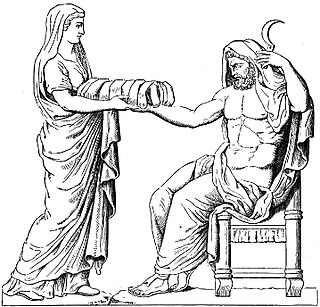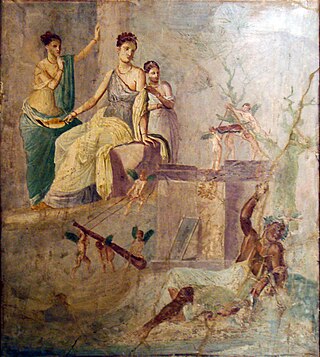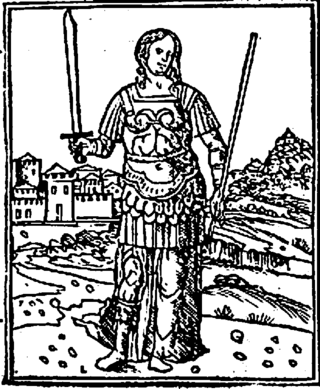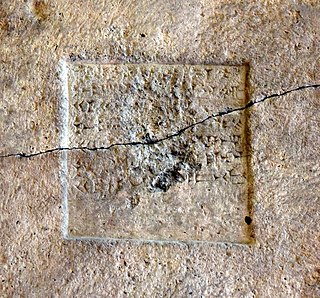
Babylonia was an ancient Akkadian-speaking state and cultural area based in the city of Babylon in central-southern Mesopotamia. It emerged as an Akkadian populated but Amorite-ruled state c. 1894 BC. During the reign of Hammurabi and afterwards, Babylonia was retrospectively called "the country of Akkad", a deliberate archaism in reference to the previous glory of the Akkadian Empire. It was often involved in rivalry with the older ethno-linguistically related state of Assyria in the north of Mesopotamia and Elam to the east in Ancient Iran. Babylonia briefly became the major power in the region after Hammurabi created a short-lived empire, succeeding the earlier Akkadian Empire, Third Dynasty of Ur, and Old Assyrian Empire. The Babylonian Empire rapidly fell apart after the death of Hammurabi and reverted to a small kingdom centered around the city of Babylon.

Rhea or Rheia is a mother goddess in ancient Greek religion and mythology, the Titan daughter of the earth goddess Gaia and the sky god Uranus, himself a son of Gaia. She is the older sister of Cronus, who was also her consort, and the mother of the five eldest Olympian gods and Hades, king of the underworld.
Belus (Latin) or Belos was the indifferent classical rendering of the Semitic words bēlu and baʿal ("lord") as a theonym, personal name, and royal title.

In Greek mythology, Omphale was queen of the kingdom of Lydia in Asia Minor. Diodorus Siculus provides the first appearance of the Omphale theme in literature, though Aeschylus was aware of the episode. The Greeks did not recognize her as a goddess: the undisputed etymological connection with omphalos, the world-navel, has never been made clear. In her best-known myth, she is the mistress of the hero Heracles during a year of required servitude, a scenario that, according to some, offered writers and artists opportunities to explore sexual roles and erotic themes.

Melqart was the tutelary god of the Phoenician city-state of Tyre and a major deity in the Phoenician and Punic pantheons. He may have been central to the founding-myths of various Phoenician colonies throughout the Mediterranean, as well as the source of several myths concerning the exploits of Heracles. Many cities were thought to be founded and protected by Melqart, no doubt springing from the original Phoenician practice of building a Temple of Melqart at new colonies. Similar to Tammuz and Adonis, he symbolized an annual cycle of death and rebirth.

Ninus, according to Greek historians writing in the Hellenistic period and later, was the founder of Nineveh, ancient capital of Assyria. The figure or figures with which he corresponds in Assyrian records is uncertain; an association or identification with Ninurta has been proposed. An identification with Shamshi-Adad I, Shamshi-Adad V, and/or a conflation of the two have also been suggested.

Bêl is a title signifying 'lord' or 'master' applied to various gods in the Mesopotamian religion of Akkad, Assyria, and Babylonia. The feminine form is Bêlit in Akkadian. Bel is represented in Greek as Belos and in Latin as Belus. Belit appears in Greek form as Beltis (Βελτις). Linguistically, Bel is an East Semitic form cognate with the Northwest Semitic Baal with the same meaning.

Semiramis was the legendary Lydian-Babylonian wife of Onnes and of Ninus, who succeeded the latter on the throne of Assyria, according to Movses Khorenatsi. Legends narrated by Diodorus Siculus, who drew primarily from the works of Ctesias of Cnidus, describe her and her relationships to Onnes and King Ninus.

Nimrod is a biblical figure mentioned in the Book of Genesis and Books of Chronicles. The son of Cush and therefore a great-grandson of Noah, Nimrod was described as a king in the land of Shinar. The Bible states that he was "a mighty hunter before the Lord [and] ... began to be mighty in the earth". Later extra-biblical traditions identified Nimrod as the ruler who commissioned the construction of the Tower of Babel, which led to his reputation as a king who was rebellious against God.

Twins appear in the mythologies of many cultures around the world. In some cultures they are seen as ominous, and in others they are seen as auspicious. Twins in mythology are often cast as two halves of the same whole, sharing a bond deeper than that of ordinary siblings, or seen as fierce rivals. They can be seen as representations of a dualistic worldview. They can represent another aspect of the self, a doppelgänger, or a shadow. However, twins can also reflect a complete opposition of the other, such as the "civilized" Gilgamesh, and the "wild" Enkidu; or in the commonly known instance of good and evil twin identities.
Thallus or Thallos, perhaps a Samaritan, was an early historian who wrote in Koine Greek. He wrote a three-volume history of the Mediterranean world from before the Trojan War to the 167th Olympiad, 112–108 BC, or perhaps to the 217th Olympiad, AD 89-93. Most of his work, like the vast majority of ancient literature, has been lost, although some of his writings were quoted by Sextus Julius Africanus in his History of the World. It is not known when he lived and wrote, but his work is quoted by Theophilus of Antioch, who died around AD 185, and most scholars date Thallus' writings to around 50 AD.
In Greek mythology, Belus was a king of Egypt and father of Aegyptus and Danaus and (usually) brother to Agenor. The wife of Belus has been named as Achiroe, or Side.

Belus or Belos in classical Greek or classical Latin texts in a Babylonian context refers to the Babylonian god Bel Marduk. Though often identified with Greek Zeus and Latin Jupiter as Zeus Belos or Jupiter Belus, in other cases Belus is euhemerized as an ancient king who founded Babylon and built the ziggurat. He is recognized and worshipped as the god of war.

Trebeta was the legendary founder of Trier according to the Gesta Treverorum.

Shamshi-Adad V was the King of Assyria from 824 to 811 BC. He was named after the god Adad, who is also known as Hadad.

Shammuramat, also known as Sammuramat or Shamiram and Semiramis, was a powerful queen of the Neo-Assyrian Empire. Beginning her career as the primary consort of the king Shamshi-Adad V, Shammuramat reached an unusually prominent position in the reign of her son Adad-nirari III. Though there is dispute in regard to Shammuramat's formal status and position, and if she should be considered a co-regent, it is clear that she was among the most powerful and influential women of the ancient Near East; she is the only known Assyrian queen to have retained her status as queen after the death of her husband and the only known ancient Assyrian woman to have partaken in, and perhaps even led, a military campaign.

In Ancient Greek religion and mythology, Cronus, Cronos, or Kronos was the leader and youngest of the first generation of Titans, the divine descendants of the primordial Gaia and Uranus. He overthrew his father and ruled during the mythological Golden Age, until he was overthrown by his own son Zeus and imprisoned in Tartarus. According to Plato, however, the deities Phorcys, Cronus, and Rhea were the eldest children of Oceanus and Tethys.

The timeline of ancient Assyria can be broken down into three main eras: the Old Assyrian period, Middle Assyrian Empire, and Neo-Assyrian Empire. Modern scholars typically also recognize an Early period preceding the Old Assyrian period and a post-imperial period succeeding the Neo-Assyrian period.















